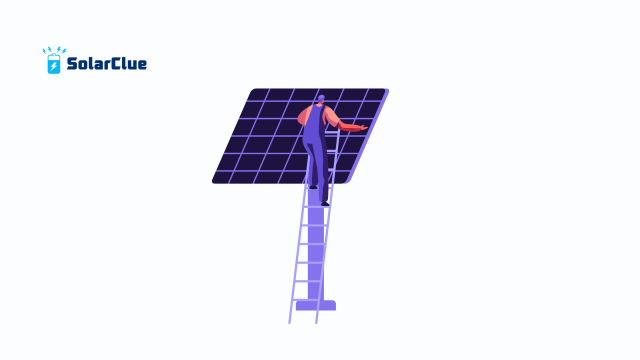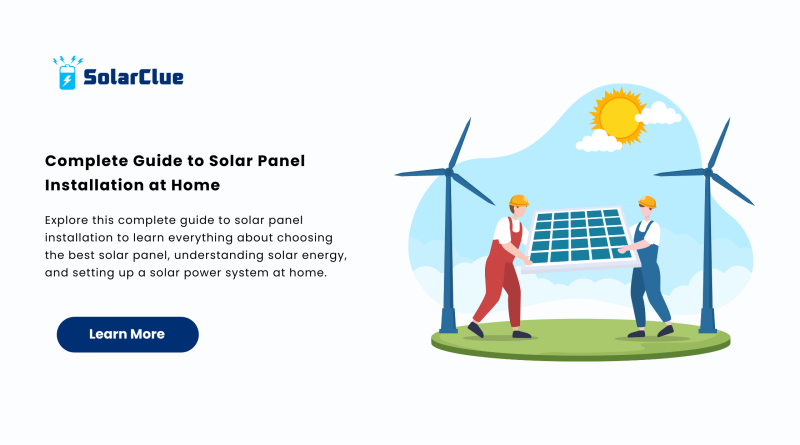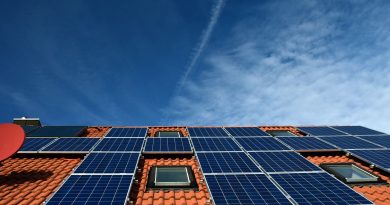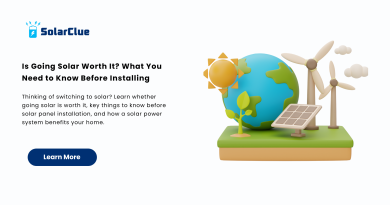Complete Guide to Solar Panel Installation at Home
Switching to solar energy is one of the smartest moves you can make—both for your wallet and the environment. But understanding how to install a solar panel for home isn’t always easy. This complete guide to solar panel installation is here to help you step-by-step through the entire process, from planning to powering your home.
Whether you’re considering solar to reduce your electricity bill or contribute to a sustainable future, this blog covers all your questions in detail. Let’s get started.
Table of Contents
- 1 Why Choose Solar Energy?
- 2 Step 1: Assess Your Energy Needs
- 3 Step 2: Evaluate Roof Space and Sunlight Exposure
- 4 Step 3: Choose the Best Solar Panel
- 5 Step 4: Decide Between On-grid and Off-grid
- 6 Step 5: Hire a Certified Solar Installer
- 7 Step 6: Understand the Components of a Solar Power System
- 8 Step 7: Monitor Performance and Maintenance
- 9 Costs and Return on Investment
- 10 Government Subsidies and Incentives
- 11 Things to Avoid During Installation
- 12 Final Thoughts
- 13 FAQs
Why Choose Solar Energy?
Before diving into installation, let’s understand why so many homeowners are turning to solar energy.
-
Cost Savings: Once installed, a solar power system drastically cuts or even eliminates your monthly electricity bills.
-
Environmental Benefits: Solar panels generate clean energy with zero emissions.
-
Government Incentives: Many state and national programs offer subsidies and tax benefits for solar adoption.
-
Energy Independence: Say goodbye to erratic electricity supply and rising power costs.
Step 1: Assess Your Energy Needs
Start by understanding how much electricity your household consumes monthly. You can find this information on your electricity bills. This step helps you determine the size of your solar power system and choose the best solar panel for your needs.
Tips:
-
Add up your average kWh usage for 12 months
-
Consider future energy needs (EV, additional appliances, etc.)
Step 2: Evaluate Roof Space and Sunlight Exposure
Your solar panel installation will depend heavily on your roof’s orientation, slope, and amount of shade. Ideally, your roof should have:
-
South-facing orientation for maximum sunlight in India
-
Minimal shading from trees or other structures
-
Enough area to fit the number of panels required for your load
Step 3: Choose the Best Solar Panel
There are three main types of solar panels:
-
Monocrystalline Solar Panels – High efficiency and space-saving
-
Polycrystalline Solar Panels – Affordable and reliable
-
Thin-film Solar Panels – Lightweight and flexible, but lower efficiency
When choosing the best solar panel, compare their:
-
Wattage rating
-
Efficiency percentage
-
Warranty period (usually 25 years)
-
Brand reputation
Also, verify BIS certification and check if your installer is MNRE-approved.
Step 4: Decide Between On-grid and Off-grid
Your solar power system can be:
-
On-grid (Grid-tied): Connected to the utility grid, allows net metering
-
Off-grid: Includes batteries to store excess power, ideal for remote areas
-
Hybrid: Combines both systems with backup battery storage
For urban homeowners, an on-grid solar panel for home system is often the most cost-effective.

Step 5: Hire a Certified Solar Installer
Professional installation ensures long-term safety and performance. A certified installer will:
-
Survey your property
-
Design a suitable solar panel installation plan
-
Handle permits and net metering application
-
Install the panels, inverter, and safety equipment
Always request an AMC (Annual Maintenance Contract) and ensure post-installation support.
Step 6: Understand the Components of a Solar Power System
Your system includes:
-
Solar Panels: Convert sunlight into DC electricity
-
Inverter: Converts DC to AC usable by home appliances
-
Mounting Structure: Holds the panels securely
-
Batteries (for off-grid or hybrid): Store unused power
-
Cables and Connectors: Ensure proper wiring and safety
Step 7: Monitor Performance and Maintenance
Once your system is operational, monitor its output using:
-
Mobile apps
-
Web dashboards
-
Inverter LCD display
Maintenance Tips:
-
Clean panels every 15–30 days (dust reduces efficiency)
-
Inspect wiring and connections annually
-
Check inverter status for errors or faults
Costs and Return on Investment
Solar panel installation cost depends on:
-
System size (kW)
-
Panel type and brand
-
Mounting structure and accessories
-
Installer service charges
A typical 3 kW solar panel for home costs around ₹1.5 to ₹1.8 lakhs after subsidies. The payback period is usually 4–6 years, with 25+ years of free power.
Government Subsidies and Incentives
The Indian government offers:
-
Up to 40% subsidy for residential rooftop solar (under PM Surya Ghar Yojana)
-
Net metering to export excess energy
-
GST benefits and soft loans
Apply through DISCOM-approved vendors or on the MNRE portal to get benefits.
Things to Avoid During Installation
-
Don’t choose panels based only on price. Focus on quality and efficiency.
-
Avoid DIY unless you’re technically trained. Incorrect installations can cause fires or poor output.
-
Never skip post-installation inspection and documentation.
Final Thoughts
Installing a solar power system is a smart investment, but it requires proper planning and execution. By following this complete guide to solar panel installation, you’re not just choosing solar energy—you’re choosing a sustainable and financially wise future.
Ready to power your home with clean energy? Explore expert recommendations and get started by visiting solarclue.com or browse detailed insights at blog.solarclue.com—your one-stop guide to all things solar.
FAQs
1. How long does solar panel installation take?
Typically, residential systems take 2–5 days depending on the system size and weather conditions.
2. Do I need permission to install solar panels?
Yes, most on-grid installations require local DISCOM approval and net metering application.
3. Can I install solar panels on an old roof?
Yes, but ensure the roof is structurally sound and may require reinforcement.
4. Are solar panels safe during storms?
Properly installed solar panels can withstand high winds and moderate storms. Use sturdy mounting structures.
5. Will my solar system work during power cuts?
Only off-grid or hybrid systems with batteries will provide backup during outages.



